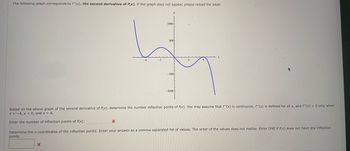
Calculus: Early Transcendentals
8th Edition
ISBN: 9781285741550
Author: James Stewart
Publisher: Cengage Learning
expand_more
expand_more
format_list_bulleted
Question

Transcribed Image Text:## Educational Website Content: Understanding Graphs of Second Derivatives
### Graph Analysis
The graph displayed represents the second derivative of a function, denoted as \( f''(x) \).
#### Graph Description
- **Axes:**
- The horizontal axis is labeled \( x \).
- The vertical axis is labeled \( y \), with values ranging from -1000 to 1000.
- **Curve Behavior:**
- The graph shows a smooth curve that intersects the \( x \)-axis at three points: \( x = -4 \), \( x = 0 \), and \( x = 4 \).
- The curve exhibits positive and negative values, indicating intervals of concavity and convexity for the original function \( f(x) \).
### Inflection Points
An inflection point occurs where the concavity of \( f(x) \) changes, which corresponds to the points where the second derivative \( f''(x) = 0 \).
#### Exercise
1. **Determine the Number of Inflection Points:**
- Based on the graph, identify how many times \( f''(x) \) equals zero.
2. **X-Coordinates of Inflection Points:**
- Enter the \( x \)-coordinates as a comma-separated list where \( f''(x) \) intersects the \( x \)-axis.
### Instructions
- Enter the number of inflection points in the first box.
- Provide the \( x \)-coordinates for the points of inflection in the second box.
- If \( f(x) \) does not have any inflection points, input "DNE" (Does Not Exist).
*Note:* Ensure the graph is properly loaded if not visible. This helps in analyzing the behavior of the function for further calculus studies.
Expert Solution
arrow_forward
Step 1

Step by stepSolved in 3 steps with 3 images

Knowledge Booster
Similar questions
- The figure is the graph of the derivative, f', of a function f on [-4,4]. AA Determine the intervals on which f is increasing. (Use the symbol u for combining intervals, and an appropriate type of parenthesis "(",")", "[","]" depending on whether the interval is open or closed.) f is increasing on Determine the intervals on which f is decreasing. (Use the symbol u for combining intervals, and an appropriate type of parenthesis "(",")", "[","]" depending on whether the interval is open or closed.) f is decreasing on Determine the intervals on which f is concave down. (Use the symbol U for combining intervals, and an appropriate type of parenthesis "(",")", "[","]" depending on whether the interval is open or closed.) f is concave down on Determine the intervals on which f is concave up. (Use the symbol U for combining intervals, and an appropriate type of parenthesis "(",")", "[","]" depending on whether the interval is open or closed.) f is concave up onarrow_forwardPlease check 4-5.arrow_forward10 y Xarrow_forward
- If the second derivative of a function f is given byf" (x) = x (x - 1) (x + 2)“, then f has points of inflection when x =arrow_forwardSince f'(x) is a function, f'(x) has its own graph, one that is based on the behavior of f(x). True Falsearrow_forwardConsider the following function. f(x) = x4 – 8x3 + 18x² + 4 | (a) Make a sign diagram for the first derivative. ---Select--- v ---Select--- v ---Select--- v ---Select--- v ---Select--- v X = X = (b) Make a sign diagram for the second derivative. ---Select--- v ---Select--- v ---Select--- v ---Select--- v ---Select--- v X = X = (c) Sketch the graph, showing all relative extreme points and inflection points. y 40 y 40 Delete PriSc GOO0 F11 Invsert DP F10 F12 DIB F7 F9 F8 Backspace Num Lock F6 F5 F4 F3 Esc F2 FnLock %23 %24 7 8. 4 Hos 1 Y W E Enter J K + // CO %#3arrow_forward
arrow_back_ios
arrow_forward_ios
Recommended textbooks for you
 Calculus: Early TranscendentalsCalculusISBN:9781285741550Author:James StewartPublisher:Cengage Learning
Calculus: Early TranscendentalsCalculusISBN:9781285741550Author:James StewartPublisher:Cengage Learning Thomas' Calculus (14th Edition)CalculusISBN:9780134438986Author:Joel R. Hass, Christopher E. Heil, Maurice D. WeirPublisher:PEARSON
Thomas' Calculus (14th Edition)CalculusISBN:9780134438986Author:Joel R. Hass, Christopher E. Heil, Maurice D. WeirPublisher:PEARSON Calculus: Early Transcendentals (3rd Edition)CalculusISBN:9780134763644Author:William L. Briggs, Lyle Cochran, Bernard Gillett, Eric SchulzPublisher:PEARSON
Calculus: Early Transcendentals (3rd Edition)CalculusISBN:9780134763644Author:William L. Briggs, Lyle Cochran, Bernard Gillett, Eric SchulzPublisher:PEARSON Calculus: Early TranscendentalsCalculusISBN:9781319050740Author:Jon Rogawski, Colin Adams, Robert FranzosaPublisher:W. H. Freeman
Calculus: Early TranscendentalsCalculusISBN:9781319050740Author:Jon Rogawski, Colin Adams, Robert FranzosaPublisher:W. H. Freeman
 Calculus: Early Transcendental FunctionsCalculusISBN:9781337552516Author:Ron Larson, Bruce H. EdwardsPublisher:Cengage Learning
Calculus: Early Transcendental FunctionsCalculusISBN:9781337552516Author:Ron Larson, Bruce H. EdwardsPublisher:Cengage Learning

Calculus: Early Transcendentals
Calculus
ISBN:9781285741550
Author:James Stewart
Publisher:Cengage Learning

Thomas' Calculus (14th Edition)
Calculus
ISBN:9780134438986
Author:Joel R. Hass, Christopher E. Heil, Maurice D. Weir
Publisher:PEARSON

Calculus: Early Transcendentals (3rd Edition)
Calculus
ISBN:9780134763644
Author:William L. Briggs, Lyle Cochran, Bernard Gillett, Eric Schulz
Publisher:PEARSON

Calculus: Early Transcendentals
Calculus
ISBN:9781319050740
Author:Jon Rogawski, Colin Adams, Robert Franzosa
Publisher:W. H. Freeman


Calculus: Early Transcendental Functions
Calculus
ISBN:9781337552516
Author:Ron Larson, Bruce H. Edwards
Publisher:Cengage Learning